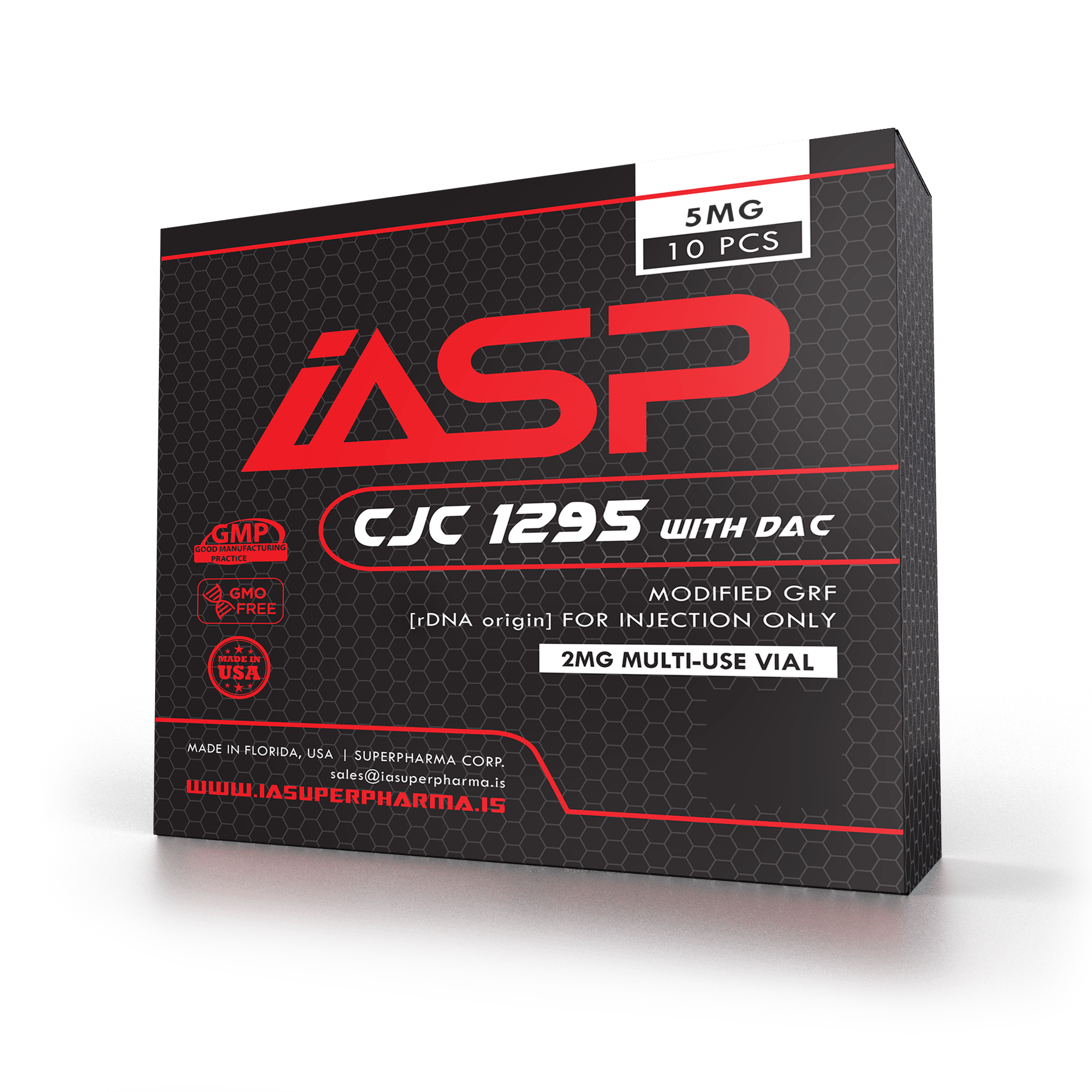This product is a box of 10 vials.
Dosage & administration:
- Half life
- 7 days
- Dosage
- 1000mcg every three days continuously
- Average Cycle Length
- Indefinite
- Bioavailability
- Estimated at 100%
How to use CJC 295
CJC 1295 is typically provided in vials containing 2 or 5 mg of lyophylized powder, though the amount can vary. The contents should be reconstituted by adding a convenient amount of sterile or bacteriostatic water. If for example 2 mL is chosen and the dosing of the vial is 2 mg, the resulting solution then has a concentration of 1 mg/mL, or 1000 mcg/mL.
At time of dosing, an insulin syringe is used to draw and then inject the desired amount. In the above example, a 1000 mcg dose would require a volume of 1 mL, or “100 IU” as marked on an insulin syringe.
Injection may be subcutaneous, intramuscular, or intravenous according to personal preference. If desired, peptide solutions from other vials, such as a vial of a GHRP product, may also be drawn into the same syringe, if there is room. This reduces the total number of injections required.
When recommending CJC 1295, I ordinarily recommend a dosage of 1000 mcg at a time, twice per week.
Combined use of CJC 1295 and a GHRP
As with Mod GRF, CJC 1295 use can be combined with use of GHRP, but if using a GHRP, for superior results I recommend combining Mod GRF with it rather than CJC 1295.
The most important reason for this is observed results. The principal cause of it is that the DAC modification results in relatively lower levels of free peptide. In and of itself, this would be a bad thing, but it’s counterbalanced by the lower levels being sustained. However, if creating peaks with a GHRP, it’s more efficient to have higher levels of free GHRH peptide in, so to speak, “lock step” with those peaks. Mod GRF does this, while CJC-1925 does not.
If choosing CJC 1295 anyway to stack with a GHRP, dosing of the CJC 1295 remains as recommended above, while GHRP dosing will be typically 100 mcg at a time, or 50 mcg at a time if using hexarelin.
What is Modified GRF (1-29)?
Modified GRF (1-29), a.k.a. CJC-1295 without DAC, is a peptide version of growth-hormone-releasing hormone (GHRH). It was first developed in the 1980s after researchers found that the first 29 amino acids of GHRH kept all the properties of the full 44-amino-acid protein. The original version, called GRF (1-29), is the smallest piece of GHRH that still has all its effects. Another shortened synthetic form of GHRH called Sermorelin or GRF 1-29 also has 29 amino acids. Modified GRF (1-29) is further changed with four swapped amino acids in its chain. These changes help prevent breakdown and oxidation during making, shipping, and use in the body. They also make it bind better to GHRH receptors.
Even though GRF worked fully, its effects didn't last long because of a very short half-life (less than 10 minutes). So, researchers altered GRF (1-29) to make its half-life longer and increase its potential for treatment. Modified GRF (1-29) is sometimes called mod GRF or tetrasubstituted GRF (1-29). The last name shows that mod GRF is different from GRF (1-29) because four amino acids were changed. Modified GRF (1-29) is the same as CJC-1295 without DAC.
Sequence: Tyr-D-Ala-Asp-Ala-Ile-Phe-Thr-Gln-Ser-Tyr-Arg-Lys-Val-Leu-Ala-Gln-Leu-Ser-Ala-Arg-Lys-Leu-Leu-Gln-Asp-Ile-Leu-Ser-Arg
Molecular Formula: C152H252N44O42
Molecular Weight: 3367.954 g/mol
PubChem CID: 56841945
CAS Number: 863288-34-0
Modified GRF has the same effects as GHRH. These include muscle growth (hypertrophy), faster wound healing, better bone growth, increased fat burning, and quicker metabolism. Modified GRF also has positive effects on the immune system and blood sugar control.
Mod GRF and the Intestine
Early studies suggested that growth hormone (GH) could help with Crohn’s disease, short bowel syndrome, and other inflammatory bowel issues. However, the benefits of GH in these cases are often outweighed by the side effects of long-term use from outside sources. This led researchers to explore whether GHRH versions like mod GRF could offer similar benefits without the serious side effects. Studies in monkeys show that mod GRF interacts with vasoactive intestinal peptide (VIP) receptors and improves bowel movement. The peptide seems to work with VIPC1, which is on the smooth muscle of the gut, reproductive, and urinary systems. Better bowel movement is very important in inflammatory bowel diseases that cause constipation. These conditions cause a lot of health problems and are hard to treat right now because of limited drug choices.
Mod GRF and Heart Function
Studies in rodent models suggest that modified GRF and other GHRH versions may help the heart pump blood better after a heart attack. This could greatly improve quality of life and lower long-term death rates in people with heart failure. The finding could apply to a range of conditions, including pulmonary hypertension, heart failure, heart attack, and various congenital heart issues.
Interaction w/ Thyroid Hormone
Problems with the thyroid gland are often linked to issues in growth hormone (GH) release. To study this connection, scientists gave modified GRF to people with hypothyroidism. They found that those taking thyroid replacement hormone had stronger responses to GRF, proving a link between thyroid hormone and GH. This is one of many ways peptides like modified GRF can help scientists better understand how the human body works.
Curious about CJC-1295?
Join our Facebook group to engage directly with thousands of others who use this product, and follow our Facebook/IG pages for hot updates and product announcements!


